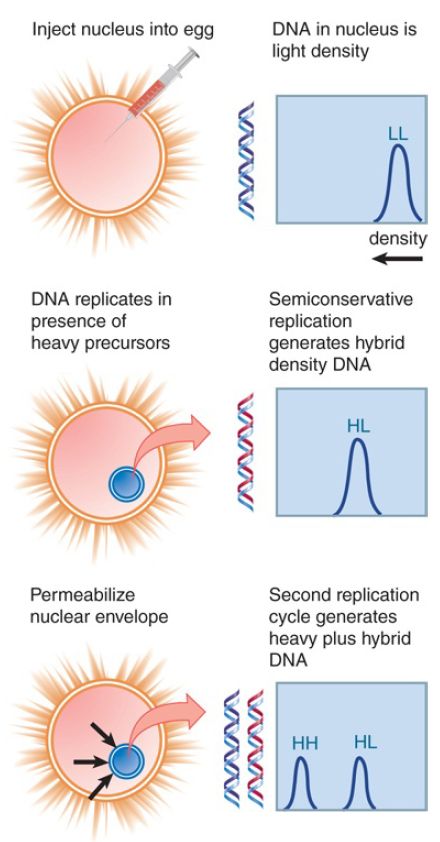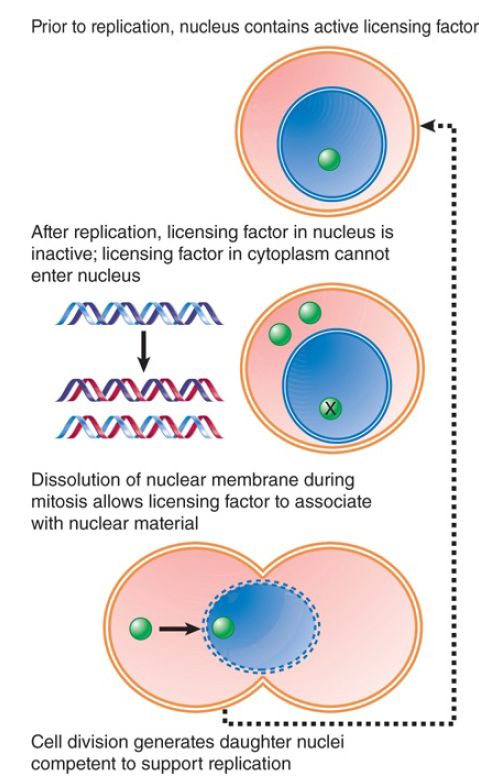


 النبات
النبات
 الحيوان
الحيوان
 الأحياء المجهرية
الأحياء المجهرية
 علم الأمراض
علم الأمراض
 التقانة الإحيائية
التقانة الإحيائية
 التقنية الحيوية المكروبية
التقنية الحيوية المكروبية
 التقنية الحياتية النانوية
التقنية الحياتية النانوية
 علم الأجنة
علم الأجنة
 الأحياء الجزيئي
الأحياء الجزيئي
 علم وظائف الأعضاء
علم وظائف الأعضاء
 الغدد
الغدد
 المضادات الحيوية
المضادات الحيوية|
Read More
Date: 15-5-2016
Date: 18-5-2016
Date: 2025-03-29
|
Licensing Factor Controls Eukaryotic Rereplication
KEY CONCEPTS
- Licensing factor is necessary for initiation of replication at each origin.
- Licensing factor is present in the nucleus prior to replication but is removed, inactivated, or destroyed by replication.
- Initiation of another replication cycle becomes possible only after licensing factor reenters the nucleus after mitosis.
A eukaryotic genome is divided into multiple replicons, and the origin in each replicon is activated once, and only once, in a single division cycle. This could be achieved by the provision of some rate-limiting component that functions only once at an origin or by the presence of a repressor that prevents rereplication at origins that have been used. The critical questions about the nature of this regulatory system are how the system determines whether any particular origin has been replicated and what protein components are involved.
Insights into the nature of the protein components have been provided by using a system in which a substrate DNA undergoes only one cycle of replication. Xenopus eggs have all the components needed to replicate DNA—in the first few hours after fertilization they undertake 11 division cycles without new gene expression—and they can replicate the DNA in a nucleus that is injected into the egg. FIGURE 1 summarizes the features of this system.

FIGURE 1. A nucleus injected into a Xenopus egg can replicate only once unless the nuclear membrane is permeabilized to allow subsequent replication cycles.
When a sperm or interphase nucleus is injected into the egg, its DNA is replicated only once. (This can be followed by use of a density label, just like the original experiment of Messelson and Stahl that characterized semiconservative replication; If protein synthesis is blocked in the egg, the membrane around the injected material remains intact and the DNA cannot replicate again. In the presence of protein synthesis, however, the nuclear membrane breaks down just as it would for a normal cell division, and in this case subsequent replication cycles can occur. The same result can be achieved by using agents that permeabilize the nuclear membrane. This suggests that the nucleus contains a protein(s) needed for replication that is used up in some way by a replication cycle, so even though more of the protein is present in the egg cytoplasm, it can enter the nucleus only if the nuclear membrane breaks down. The system can in principle be taken further by developing an in vitro extract that supports nuclear replication, thus allowing the components of the extract to be isolated and the relevant factors identified.
FIGURE 2 explains the control of reinitiation by proposing that this protein is a licensing factor. It is present in the nucleus prior to replication. One round of replication either inactivates or destroys the factor, and another round cannot occur until additional factor is provided. Factor in the cytoplasm can gain access to the nuclear material only at the subsequent mitosis when the nuclear envelope breaks down. This regulatory system achieves two purposes. By removing a necessary component after replication, it prevents more than one cycle of replication from occurring. It also provides a feedback loop that makes the initiation of replication dependent on passing through the cell cycle.

FIGURE 2. Licensing factor in the nucleus is inactivated after replication. A new supply of licensing factor can enter only when the nuclear membrane breaks down at mitosis.



|
|
|
|
لخفض ضغط الدم.. دراسة تحدد "تمارين مهمة"
|
|
|
|
|
|
|
طال انتظارها.. ميزة جديدة من "واتساب" تعزز الخصوصية
|
|
|
|
|
|
|
مشاتل الكفيل تزيّن مجمّع أبي الفضل العبّاس (عليه السلام) بالورد استعدادًا لحفل التخرج المركزي
|
|
|